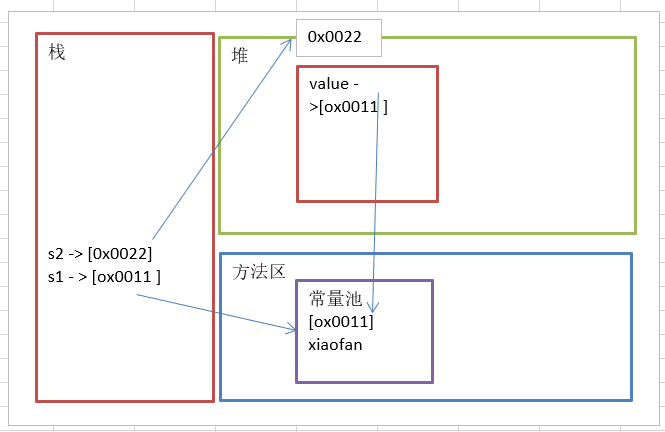Java基础之:String类
String对象用于保存字符串,也就是一组字符序列
常量对象:字符串常量对象是用双引号括起来的字符序列,例如:"小范","12.34","xiaofan"等
字符串的字符使用Unicode字符编码,一个字符(不区分字母还是汉字)占两个字节。

String对象的两种创建方式
第一种:String s1 = "xiaofan";
第二种:String s2 = new String("xiaofan");
说明:
方法一是直接赋值,而方法二是调用构造器。方法一会直接将引用指向常量池中的"xiaofan",而方法二会先在堆中创建一个空间,在此空间中放入指向常量池"xiaofan"的地址,再让栈空间的对象名指向堆地址。

由于这两种创建方式的不同指向,会出现很多字符串比较是否相等上的问题。
简单案例
package class_string;public class ClassTest { public static void main(String[] args) { String s = "hello"; //常量池中创建hello,指向它 String ss = new String ("hello"); //堆中创建对象,指向常量池中的hello System.out.println(s.equals(ss)); //比较内容,T System.out.println(s == ss); //比较地址,F String a = "abc"; String b = "abc"; // 因为上面a已经在常量池中创建了abc,所以b直接指向b就可以了 System.out.println(a.equals(b)); //比较内容,T System.out.println(a == b); //比较地址,T String x = new String("XYZ"); String y = new String("XYZ"); //x、y都在堆中创建了对象,但它们的对象都指向常量池中的XYZ System.out.println(x.equals(y)); //比较内容,T System.out.println(x == y); //比较地址,F System.out.println("============"); String a1 = "abc"; // a1指向 常量池 String b1 =new String("abc");//b1 指向堆 System.out.println(a1.equals(b1)); //T , 比较内容 System.out.println(a1==b1); // F,比较地址 System.out.println(a1==b1.intern()); //T , b1.intern() 指向常量池的"abc" System.out.println(b1==b1.intern());//F , 对象b1的堆地址和常量池中"abc"的地址比较 /* b1.intern() 方法最终返回的是常量池的地址(对象) * 当调用 intern 方法时,如果池已经包含一个等于此 String 对象的字符串 * (用 equals(Object) 方法确定),则返回池中的字符串。 * 否则,将此 String 对象添加到池中,并返回此 String 对象的引用 */ System.out.println("============"); class Person{ private String name; } Person p1 = new Person(); p1.name = "chuannong"; Person p2 = new Person(); p2.name = new String("chuannong"); System.out.println(p1.name.equals(p2.name)); //T System.out.println(p1.name == p2.name); //F,p1.name 指向常量池,p2.name 指向堆空间 System.out.println(p1.name == "chuannong"); //T System.out.println(p1.name.intern()); //返回"chuannong" }}
字符串的特性
可以从最开始介绍String类的时候看到,它的对象底层是保存在一个final数组中的。
所以对于String对象保存的字符串来所,一个字符串对象一旦分配,其内容就是不可变的。
package class_string;/** * String is final */public class ClassTest02 { public static void main(String[] args) { //在常量池中创建了两个对象,"abc"、"hello" String a = "abc"; a = "hello"; //在常量池中创建了一个对象,"abchello",可以理解为,abc与hello并没有被指向引用,所以不需要创建 String b = "abc" + "hello"; //编译器会自动的处理"+",将abc 和 hello 拼接起来 //在常量池中创建了三个对象,"xiao"、"fan"、"xiaofan" String c = "xiao"; //有c指向"xiao",所以创建 String d = "fan"; //同理 String e = c + d ; /* * 因为String对象 底层是放在 private final char value[]; 这里面的 * 所以String是final的,若想要进行拼接或更改字符串,只能是重新在常量池中创建对象 */ }}String类使用
了解了String对象两种声明方式不同,以及字符串特性之后。就又会出现一些对于字符串声明上的问题。
简单案例
package class_string;public class ClassTest03 { String str = new String("good"); final char[] ch = { 't', 'e', 's', 't' }; public static void main(String[] args) { ClassTest03 ex = new ClassTest03(); ex.change(ex.str, ex.ch); System.out.print(ex.str + " and "); System.out.println(ex.ch); } public void change(String str, char ch[]) { str = "test"; ch[0] = 'g'; }}程序输出:good and gest
案例理解:
程序加载时,首先在栈空间创建main方法空间,创建ex对象
在ex对象的堆空间中,创建一个String引用str指向另外一个堆空间,此堆空间中放"good"在常量池中的地址
在ex对象的堆空间中,创建一个char[]引用ch 指向另外一个堆空间,此堆空间存放 { 't', 'e', 's', 't' }
在栈空间中创建change方法空间,传入对象ex的str与ch引用地址
str = "test" ,在常量池中创建"test",返回给str,即将change方法中的str的引用改变,不再指向堆空间的地址,而变为指向常量池中的"test"
ch[0] = 'g' ,将change方法中的ch[0]该为g,即直接改变堆空间中的ch数组
change方法结束,change方法空间销毁,此时 main方法空间中的str并没有改变,ch数组的第一个改变为g,常量池中多了一个"test"。

String类的常用方法
第一部分:
package class_string;public class StringMethods { public static void main(String[] args) { String username = "JOHN"; // 2.equalsIgnoreCase 忽略大小写的判断内容是否相等 if ("john".equalsIgnoreCase(username)) { System.out.println("Success!"); } else { System.out.println("Failure!"); } // 3.length 获取字符的个数,字符串的长度 System.out.println("小范".length()); //输出:2 // 4.indexOf 获取字符在字符串对象中第一次出现的索引,索引从0开始,如果找不到,返回-1 String s1 = "wer@terwe@g"; int index = s1.indexOf('@'); System.out.println(index);//输出:3 // 5.lastIndexOf 获取字符子啊字符串中最后一次出现的索引,索引从0开始,如果找不到,返回-1 String s2 = "wer@terwe@g@"; int index2 = s1.lastIndexOf('@'); System.out.println(index);//输出:3 // 6.substring 截取指定范围的子串 String name = "hello,小范"; System.out.println(name.substring(6));// 截取后面的字符,输出:小范 System.out.println(name.substring(0, 5));//输出:hello }}
第二部分:
package class_string;public class StringMethods02 { public static void main(String[] args) { // 1.toUpperCase转换成大写 String s = "heLLo"; System.out.println(s.toUpperCase()); // 2.toLowerCase System.out.println(s.toLowerCase()); // 3.concat拼接字符串 String s1 = "小范"; s1 = s1.concat("小黄").concat("小雨").concat("together"); System.out.println(s1); // 4.replace 替换字符串中的字符 String s2 = "小范 and 小黄 小黄 小黄 小黄"; s2 = s2.replace("小黄", "小雨"); System.out.println(s2); // 5.split 分割字符串, 对于某些分割字符,我们需要 转义比如 | \\等 System.out.println("======================"); String poem = "鹅鹅鹅,曲项向天歌,白毛浮绿水,红掌拨清波"; String[] split = poem.split(","); for (int i = 0; i < split.length; i++) { System.out.println(split[i]); } System.out.println("======================"); String poem2 = "E:\\附加项目\\附加-project"; String[] split3 = poem2.split("\\\\"); for (int i = 0; i < split3.length; i++) { System.out.println(split3[i]); } // 6.toCharArray 转换成字符数组 System.out.println("======================"); String s4 = "happy"; char[] chs = s4.toCharArray(); for (int i = 0; i < chs.length; i++) { System.out.println(chs[i]); } // 7.compareTo 比较两个字符串的大小,如果前者大,则返回正数,后者大,则返回负数,如果相等,返回0 System.out.println("======================"); String a = "jchn"; String b = "jack"; System.out.println(a.compareTo(b)); // 返回值是 'c' - 'a' = 2的值 System.out.println("a".compareTo("d")); // 返回值是 'a' - 'd' = -3的值 System.out.println("a".compareTo("a")); // 返回值是 'a' - 'a' = 0的值 // 8.format 格式字符串 /* * 占位符有: %s 字符串 %c 字符 %d 整型 %.2f 浮点型 * */ System.out.println("======================"); String name = "john"; int age = 10; double score = 98.3 / 3; char gender = '男'; // String info = // "我的姓名是"+name+"年龄是"+age+",成绩是"+score+"性别是"+gender+"。希望大家喜欢我!"; String info = String.format("我的姓名是%s年龄是%d,成绩是%.2f性别是%c.希望大家喜欢我!", name, age, score, gender); System.out.println(info); }}程序输出:
HELLO
hello
小范小黄小雨together
小范 and 小雨 小雨 小雨 小雨
========================
鹅鹅鹅
曲项向天歌
白毛浮绿水
红掌拨清波
========================
E:
附加项目
附加-project
========================
h a p p y
========================
2 -3 0
========================
我的姓名是john年龄是10,成绩是32.77性别是男.希望大家喜欢我!
简单应用案例
package class_string;import java.util.Scanner;/** * 判断邮箱是否合法,要求里面必须包含@和. 而且 @ 必须在. 的前面 案例:不使用系统提供的trim 方法,自己写一个myTrim方法,去除字符串两端的空格, 比如 " hello world " => 返回 "hello world" */public class ClassWork01 { public static void main(String[] args) { Scanner scanner = new Scanner(System.in); System.out.println("请输入邮箱:"); String email = scanner.next(); if(legalEmail(myTrim(email))) { System.out.println("输入正确,你的Email地址为:" + email); }else { System.out.println("输入错误!"); } } public static String myTrim(String email) { String temp = ""; for(int i = 0;i<email.length();i++) { //去除前面的空格 if(email.charAt(i) != ' ') { temp = email.substring(i); break; } } for(int i = temp.length() - 1;i >= 0;i--) { //去除后面的空格 if(temp.charAt(i) != ' ') { email = temp.substring(0,i); break; } } return email; } public static boolean legalEmail(String email) { if(email.indexOf("@") < 0 && email.indexOf(".") < 0) { //没有@和. return false; }else { if(email.indexOf("@") != email.lastIndexOf("@")) { //不止一个@ return false; }else { if(email.indexOf("@") > email.indexOf(".")) { //"."不在@之后 return false; } } } return true; }}
原文转载:http://www.shaoqun.com/a/501419.html
ideal:https://www.ikjzd.com/w/2286
c79:https://www.ikjzd.com/w/1016
Java基础之:String类String对象用于保存字符串,也就是一组字符序列常量对象:字符串常量对象是用双引号括起来的字符序列,例如:"小范","12.34","xiaofan"等字符串的字符使用Unicode字符编码,一个字符(不区分字母还是汉字)占两个字节。String对象的两种创建方式第一种:Strings1="xiaofan";第二种:Strin
gem:gem
i号店:i号店
惠州的双月湾和巽寮湾哪个好玩点?:惠州的双月湾和巽寮湾哪个好玩点?
亚马逊FBA补货中有哪些逻辑思维?:亚马逊FBA补货中有哪些逻辑思维?
丽江概况 :丽江概况
No comments:
Post a Comment